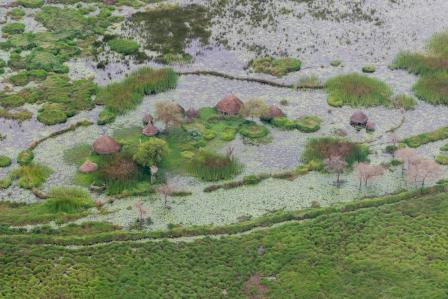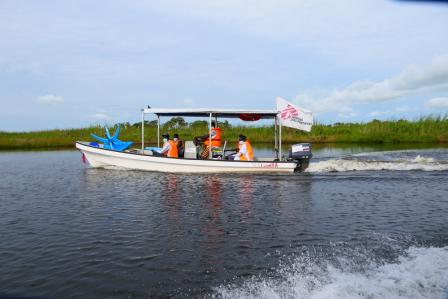South Sudan: Hundreds of thousands still living in precarious conditions months after floods
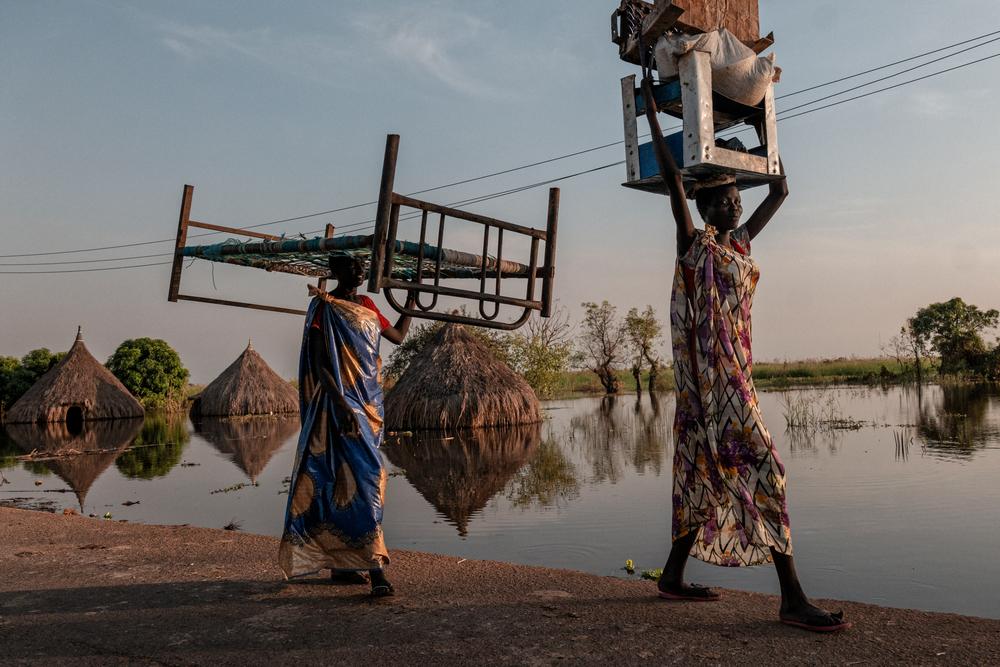
Women carry pieces of furniture and goods in a flooded area of Unity State. Across Unity state people’s homes and livelihoods (crops and cattle), as well as health facilities, schools, and markets, are completely submerged by floodwaters. South Sudan, 2021. © Sean Sutton
Eight months since the beginning of the flooding, people in Unity State in northern South Sudan are still facing precarious living conditions and are at risk to outbreaks of infectious and waterborne diseases, increased food insecurity and malnutrition, especially populations living in make-shift camp sites.
When the floodwater levels started rising in her village, 21-year-old Nyabeel (name has been changed) and her husband were torn about what to do. Leaving their land, which they relied on for food, was a tough decision. “We spent three days moving. It was challenging, with four children and a herd of goats,” she says.
Eight months on since flooding began, people in Unity State, northern South Sudan, continue to suffer, stuck in poor living conditions and at risk of outbreaks of infectious and waterborne diseases. Spread across several makeshift camp sites, they face food insecurity, a loss of income, malnutrition, and a lack of safe drinking water. An estimated 835,000¹ people have been affected.
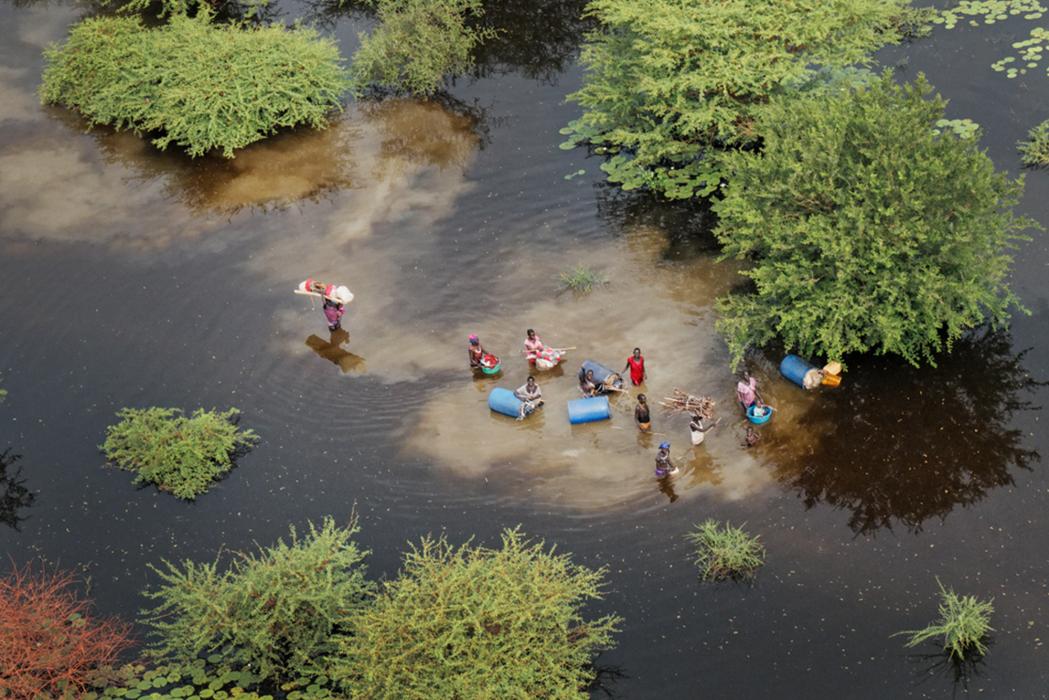
Families heading to dry land in Bentiu. 835,000 people have been directly affected by the flooding. South Sudan, 2021. © Sean Sutton
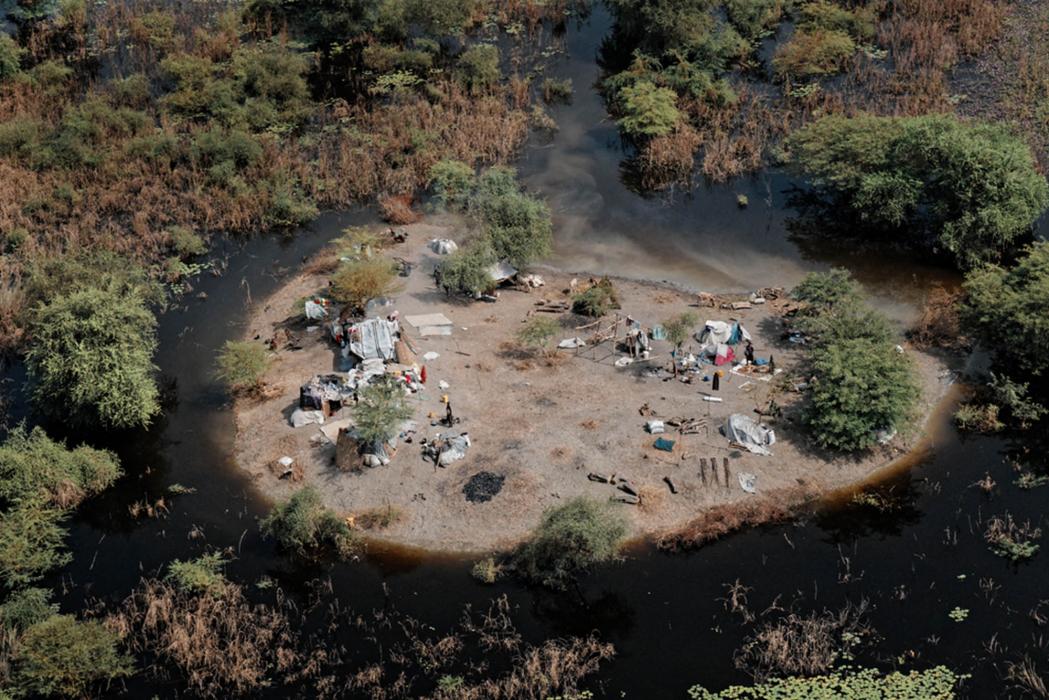
Some communities have managed to keep going in extremely difficult circumstances. The water levels are still rising even though the rains have stopped. Villages are still flooding as their dikes fail. Families are also still arriving in Bentiu - after walking for days pulling makeshift tarpaulin rafts through the flood, filled with their only belongings and their children. There is no sign of the flooding subsiding. South Sudan, 2021. © Sean Sutton

“We are from Jazeera village and we all fled the flooding in October. Nyakok is two and started getting sick with pneumonia. We brought her here ten days ago and she is improving,” says a patient at Doctors Without Borders hospital in Bentiu camp. South Sudan, 2021. © Sean Sutton
In her village, Nyabeel had relied on cultivating her land and milk from her goats for food. “We had a more stable life than the one here, now we eat one meal a day of maize.” Nyabeel had brought her one-year-old to Doctors Without Borders' mobile clinic in Kuermendoke camp, Rubkona town, for treatment for severe malnutrition and essential vaccinations. Kuermendoke is one of three camps that have high percentage of children under five suffering from severe acute malnutrition. The impact of the flooding is palpable.
Our nutritional survey demonstrated that the severe acute malnutrition prevalence in the camps is well above the WHO’s 2% emergency threshold. When you walk through the camps, you see malnourished children, people collecting dirty flood water to drink, cattle collapsing and their carcasses everywhere. Such poor conditions are harming people’s health.Dr. Reza Eshaghian, medical team leader
Initial FAO² studies suggest about 65,000 hectares of cultivated land have been damaged due to floods, while over 800,000 livestock died across eight of South Sudan’s 10 states. Having lost so much of their cattle, many displaced women are resorting to collecting firewood to make an income. Increases in food commodity prices are making it more difficult for displaced people to get food, however.
With an 80 per cent increase in admissions to the Inpatient Therapeutic Feeding Centre (ITFC), Doctors Without Borders has opened a third ITFC ward at its hospital in Bentiu IDP camp³. Doctors Without Borders teams are also running mobile clinics that visit camps in and around Mayom region, Bentiu and Rubkona, responding to malaria, malnutrition and acute watery diarrhea.
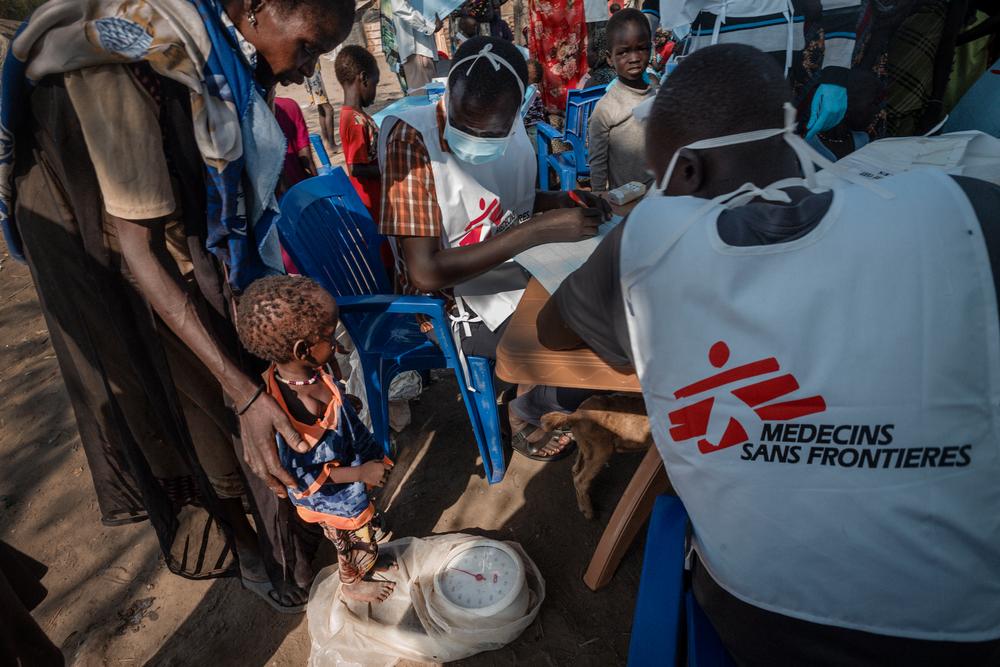
A child is weighed at a mobile clinic on Rubkona. South Sudan, 2021. © Sean Sutton
For most of those displaced, it’s become almost impossible to find safe drinking water. “Our only source of water for drinking, cooking and washing is the floodwater,” says Nyapal, a mother of four.
Before the flooding around Bentiu, sanitation facilities in the IDP camp were already in a critical condition and rarely maintained. To reduce the risk of outbreaks, Doctors Without Borders has set up a sewage treatment plant inside the camp to contain and treat fecal waste.
“For a while, flooding meant it was impossible to access the waste treatment ponds. This led to an accumulation of sewage in the camp latrines, which then overflowed into the open sewer canals, where children frequently play,” says Cawo Yassin Ali, water and sanitation team leader in Doctors Without Borders' emergency team deployed for the flood response.
With the water levels slowly starting to recede around Bentiu, it’s still not clear when Nyabeel, Nyapal and thousands of other displaced people will be able to return home.
Until people can return home, they will be forced to continue living in such precarious conditions. This poses an added challenge for humanitarian actors, requiring them to not lose sight of responding to immediate needs while recognizing the protracted nature of this crisis and meeting corresponding standards beyond the initial emergency threshold.
“There are immense needs, including the need for proper shelters, clean water and sanitation infrastructure, quality health care, food security and livelihood support. Humanitarian actors, donors and the South Sudanese Government need to act now, before it is too late. They cannot afford to wait any longer,” says Dr. Eshaghian.
Doctors Without Borders has been working in South Sudan since 1983, operating now over 14 projects across the country, delivering life-saving medical services to communities most in need of them. Doctors Without Borders teams work in hospitals and clinics throughout the country, running some of our biggest programmes worldwide. Our teams provide basic and specialised healthcare and respond to emergencies and outbreaks affecting isolated communities, internally displaced people and refugees from Sudan. Doctors Without Borders teams continue with COVID-19 pandemic preparedness and working in collaboration with the Ministry of Health.
¹ OCHA, South Sudan: Flooding Situation Report No., 14 December 2021
² Floods in 2021 killed nearly 800-thousand livestock and destroyed more than 37-thousand tons of crops in South Sudan, FAO
³ Formerly a Protection of Civilians site, and the biggest camp for internally displaced people due to the recent civil wars in South Sudan

